We all make mistakes – they’re part of the creative process. You can see a few of ours in this coconut milk volcano post, La Croix soap tutorial, and lilac soap post. Rather than focusing on the mistakes, we encourage people to focus on what they can improve for the next batch. You may even find the soap turned out better than you planned.
We asked members of the soapmaking community to share some of their memorable mistakes and how to fix them. Find their answers below.
Karen, Mooka Made This
I’ve always had a problem with overmixing and working with fluid soap batter. I finally thought I poured a perfect Zebra Swirl and was doing a happy dance when I dropped my spoon right in the middle of my freshly-poured soap! I was so heartbroken I almost dumped out the whole thing. I’m happy I decided to wait it out and was quite surprised when I cut it – the best part was where I dropped the spoon into the batter.
Sometimes soap magic happens in spite of those little mishaps, and it pays to be patient.
It was such a nice soap I recently tried to recreate the same mishap!
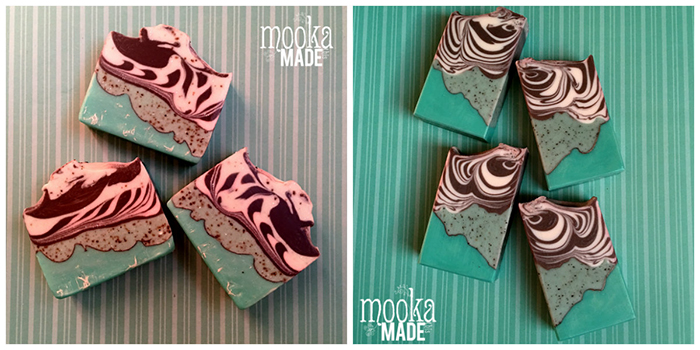 The soap on the left is the original spoon design, the soap on the right is Karen’s recreation.
The soap on the left is the original spoon design, the soap on the right is Karen’s recreation.
Mo and Jules, Lather & Co.
Soaping disasters?! There are near misses every day! We actually had one at our studio this week. Let’s talk about CASTOR OIL!!! It’s thick, viscous and slow to pour from the 35 lb. cube’s spigot. Impatiently waiting for my bucket to fill, I got sidetracked and… walked away. I came back to my station to find our floors gleaming with thick syrupy oil. It was EVERYWHERE!! It must have been at least 20 minutes of slow overspill.
At first I wanted to cry, but then I remembered my grandmother’s trick – baking soda!!! Luckily, we have plenty on hand, so I dumped it on the spill and using towels, rubbed it into the oil. The baking soda worked like a charm!! It absorbed the oil to the point that I was actually able to sweep it up! It was amazing. Moving forward, I will be setting a timer!!
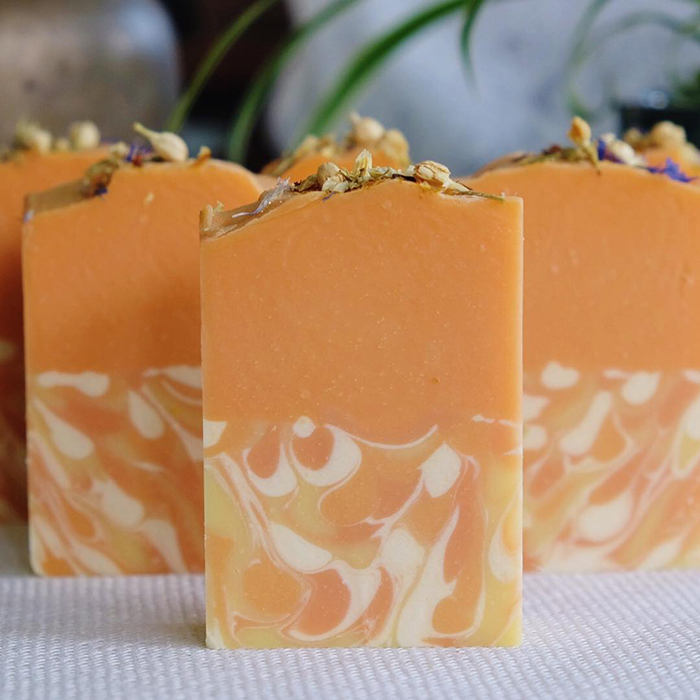 Beautiful Kumquat Soap by Lather & Co.
Beautiful Kumquat Soap by Lather & Co.
Danielle, Borden Acres
One time, in the beginning of my soaping days, I was in a hurry and completely forgot to add my lye mixture!!! I was standing there with my stick blender forever, completely perplexed as to why I couldn’t reach a medium trace! It was a recipe I’ve made before, so I just couldn’t figure it out. And kept stick blending away with steam practically coming out of my ears.
That’s when I saw the lye mixture sitting on the top shelf. Hahaha! I had originally put it away in a safe place to cool. Out of sight, out of mind I guess.
Thankfully, this was a simple mistake with a simple fix. But it taught me to slow down and make sure I’m checking everything off my list. Because I was in a hurry, it ended up taking me more time in the long run. “Slow is smooth, and smooth is fast,” right?
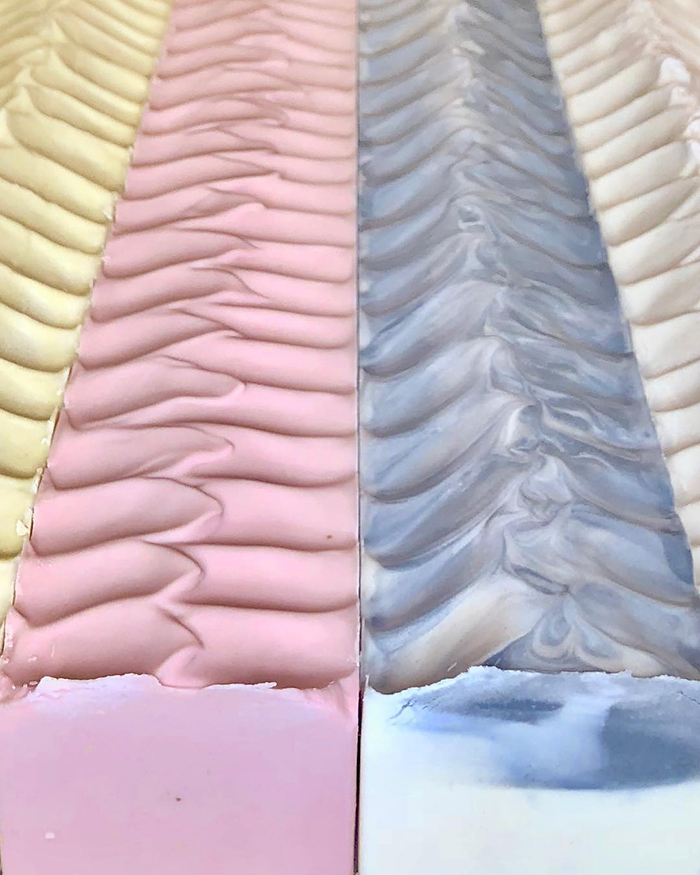 A collection of lovely goat milk soap by Borden Acres.
A collection of lovely goat milk soap by Borden Acres.
Kim, Freshwater Studio
There’s a lot of trial and error that goes into learning to make soap. It’s fun to test different ingredients and additives, change batch sizes and experiment with designs. And no matter the planning you do before you start to soap, sometimes you can’t account for a bit of forgetfulness or good-old human error. Thankfully I have yet to forget any really crucial ingredients for a batch (though I’m sure that will happen some day…), but I did recently finish up a lovely batch of soap only to realize my fragrance oil was still sitting on the countertop. It never made it into the soap! And by that time it was too late to do anything about it. I was so, so frustrated with myself – that fragrance was so good!
After beating myself up for a while and thinking I’d wasted my time, I realized the best way to fix this particular mistake was just to change my mindset about it. There was no way to change what had happened, and I still had a perfectly good, albeit unscented, soap. And unscented soaps are actually great! In fact, some people prefer their soaps unscented for numerous reasons.
So, instead of being hard on myself for not making the perfect soap I had envisioned, I learned to pat myself on the back for making a soap that still turned out beautifully and that I could now offer to a broader range of customers, some of whom might not have bought my other (scented) soaps otherwise. Plus, it turned out to be just another opportunity for me to practice and perfect this particular soap recipe. And given the countless creative possibilities of cold process soapmaking, any opportunity to practice is a good one – whether or not you end up with the exact soap you had originally planned.
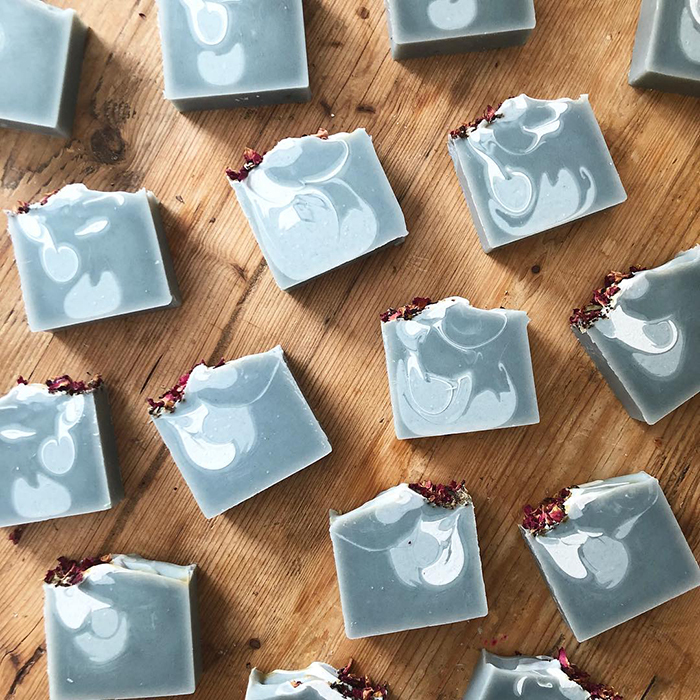 Freshwater Studio’s gorgeous unscented Indigo soap.
Freshwater Studio’s gorgeous unscented Indigo soap.
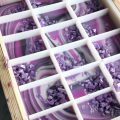
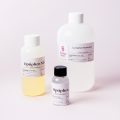

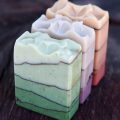
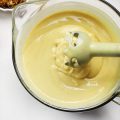
Hello. I’m a newbie at soap making. Is there any recipes that use soybean oil or vegetable oil?. I don’t have access to palm oil. The oils I have at hand are:- Soybean, Coconut,Canola, Vegetable oil. A small amt of Cocoa butter amd Shea butter. Any suggestions?
We don’t have any recipes using soybean or vegetable oil. We don’t normally recommend soaping with vegetable oil since the specific mix of oils can changed based on the market so it can have consistency problems. It is included on our Lye Calculator though if you want to give it a try.
Lye Calculator: https://www.brambleberry.com/Pages/Lye-Calculator.aspx
Find out more about formulating your own recipe in this post: https://www.soapqueen.com/bath-and-body-tutorials/tips-and-tricks/formulating-cold-process-recipes/
Please I am very new here and still doing research on how I can start my own business in cold process soaps preferably laundry bar soaps, am looking at a very foaming and lather power and long lasting kind of soap. So far I have not gotten any information here about laundry bar soaps and I really need help
We have two different laundry soap recipes you can look at. This one: https://www.soapqueen.com/bath-and-body-tutorials/home-crafts/natural-laundry-soap-natural-dryer-sheet-recipe/
This one: https://www.soapqueen.com/bath-and-body-tutorials/home-crafts/three-diy-laundry-soap-recipes/
Recently, I was making pink grapefruit soap with pink kaolin clay & grapefruit essential oil. I mixed it & put in the mold & saw the grapefruit essential oil sitting on the counter. My unscented soap is pretty…should be ready to try out soon.
I do feel for you – just made supposed Apple&Cinnamon soap – managed a lovely hanger swirl design of dark red, white and pale cinnamon – and there was the fragrance sitting on the counter. . . .
However I decided to re-make the soap WITH the fragrance and the fragrance almost seized the soap; just had to slam all the colors together in the mold to rescue the whole batch. Turned out OK
My third attempt at cold processed and I had a really great design in mind… not sure what happened because once I stick blended the oils and lye water it started to set up before I could even add the colourants or fragrance oils… I thought I had got it between a light and medium trace but apparently I was wrong so I ended up just hand mixing them in and plopping them into the mold so God knows what it will look like:-/
I just made my second batch of soap. The first one turned out great. I turned around to remove my gloves and my trace was a big blob that I tried to shape into my mold but that wasn’t happening. What did I do wrong?
It sounds like your soap accelerated on you and even started to seize. This can be due to the fragrance oil you used, certain additives and sometimes your temperatures.
Soap Behaving Badly: https://www.soapqueen.com/bath-and-body-tutorials/tips-and-tricks/soap-behaving-badly/
How to Soap with Accelerating Fragrance Oils: https://www.soapqueen.com/bath-and-body-tutorials/tips-and-tricks/how-to-work-with-accelerating-fragrance-oils/
I had a major fail on my latest batch. I was making CP soap and I used the wrong lye! I have KOH for my hot process liquid soaps and I grabbed the wrong one. Such a careless mistake! Is there any way to salvage the batch?
You can change it into a liquid soap recipe! You can also play with cream soaps (a blend of Sodium and Potassium Hydroxide is used) but we haven’t done any testing on them yet!
customized soap boxes are always important for the packaging of soap.
The other day, I had a partial fail. I had read about making soap with pine tar and decided I had to try it. I did several things that complicated it for me. First, I used beeswax; second, I water discounted; third, I tried an untested ingredient with an already complicated recipe. Suffice it to say, the recipe came together incredibly fast without an immersion blender. It came together in about 30 seconds and was like trying to force hardening chocolate into the cavity molds. I highly recommend using a loaf mold when making pine tar soap. Fortunately, my soap just looks terribly ugly but is perfectly usable, and I can’t wait to try it!
I personally think it is easier to make pine tar soap as a hot process soap. I tried making it cold process once and it separated about 20 minutes after I poured it into my mold. I ended up having to hot process of anyway! Haha! I also find that your scent doesn’t come through very much because of how strong the pine tar is. If you end up making a hot process pine tar batch, I would add a tablespoon of plain yogurt or buttermilk at the end of the cook to help thin the soap out. I hope you like your soap!
My stepdaughters came over to make soap, and one made a beautiful vivid blue and orange “Broncos” swirl. When we were done we realized we had forgotten to add the fragrance… too many cooks in the kitchen asking too many questions, and I got distracted! She decided she really wanted the fragrance, so we dumped the still-soft soap out, mixed in the FO, and spooned it back into the mold. It came out a hideous olive green, but at least it smelled nice.
One of my first batches of hot process erupted like a volcano because it was too hot. Once I was able to clean everything off of the counters and floor, I was perplexed as to what to do with the rest of soap because the lye still active. Keep in mind that I was a complete novice at this point. So I turned to my husband for his advice. His solution was to bury the entire Crock-Pot in the backyard.
I like your husband’s advice, that’s too funny!
Right here is the perfect site for anybody who really wants to
understand bath and body. Thanks for sharing this tutorial.
We all experience such failures and collapses once going through this procedure and they turn out to be the opportunities to learn from our mistakes. Therefore, thanks for posting this, giving us the guided knowledge & information.
Oh my gosh… I have done the castor oil thing soooo many times! Thanks for the baking soda trick! Beautiful pictures and stories, as usual.
Looking for tips when working with cinnamon essential oil pretty please, I’ve had it ruin to many batches. Thank you 😉
Cinnamon Oil can accelerate trace because of the spice notes.
Find out how to work with accelerating oils in this post: https://www.soapqueen.com/bath-and-body-tutorials/tips-and-tricks/how-to-work-with-accelerating-fragrance-oils/
Cinnamon essential oil is also a strong skin irritant. You have to use VERY little to be skin safe. I have found that if I just whisk it at the very end and pour immediately, I have time to do it. You can also make it with hot process so you don’t have to worry about acceleration.
We’ve all had designs that failed and I’m certainly no exception. My biggest ever flop came from what I can only imagine must have been bad lye. I’m very meticulous about measuring accurately and I’m certain to this day that I did. When it was time to try to unmold, it slid out of the mold with oil, the layers slid off each other with a lot of oil dripping. It didn’t fully saponify and it had ample time. I rebatched it which turned it dark tan, but the scent (pomegranate and black currant) survived the cook. The soap set up but was too soft for months. About six months later it was very moisturizing and I have one bar one year later waiting for the dry winter months. The lather is low, but it works and is really gentle.
I’ve made some whoppers! They became opportunities to learn how to fix mistakes. I have forgotten to add some of my oils (fix: rebatch with missing oils), forgotten fragrance (some people like no scent and it’s still great soap), miscalculated lye and soap was just wrong! (Fix: this was tough, backtracked and figured out what was needed. Rebatched and made an even better soap.). Oh, then the time I could find my stirring spoon. Yep, in the bottom of the poured soap. I’ve never had an injury because I’m religious about safety precautions.
Thank you for these stories. It is nice to have some encouragement from more experienced soapers. One of the nice things about cold process soapmaking is, as long as you don’t have an issue with the lye, the mistakes that are made even if the soap is ugly as can be it is still just as nourishing and cleansing as if it looked how you wanted it to. This makes it much more fun and enjoyable. A special thanks to Soap Queen; you gave me the confidence and information as well as a dizzying array of fantastic products through Bramble Berry.